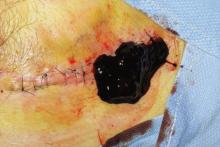LAS VEGAS – A perioperative hemorrhage in a patient undergoing Mohs surgery is a bloody mess, but a thrombosis causing a stroke is a catastrophe.
"Bleeding is overemphasized in our specialty, because it's dramatic. But it is very inconsequential in contrast to thrombosis, which is probably underappreciated," Dr. Clark C. Otley said at the annual meeting of the American College of Mohs Surgery.
He reviewed the literature on the risks for hemorrhage in patients on anticoagulant therapy who undergo Mohs surgery and the risks for thrombosis in patients who stop their anticoagulant therapy before Mohs.
"The bottom line is that bleeding happens, but nobody dies. That's in contrast to the thrombotic data, where people do die," said Dr. Otley, professor of dermatology at the Mayo Clinic, Rochester, Minn.
The consequences of a thrombotic episode are so much greater than the impact of a hemorrhagic complication that he recommended continuing medically necessary anticoagulants in most cases. "Take extra care with clopidogrel plus aspirin and with warfarin. Taking patients off these, especially if they have a fresh stent, is not the right thing to do," he said.
A survey of 168 American College of Mohs Surgery members in 2003 gathered reports of thrombotic complications within 3 days of Mohs surgery in 46 patients who had stopped anticoagulant therapy, Dr. Otley noted. These included stroke in 24 patients, transient ischemic attack in 8, MI in 5, cerebral emboli or death in 3 patients each, pulmonary embolus in 2, and blindness in 1 patient (J. Am. Acad. Dermatol 2003;48:233-7).
A separate survey of more than 270 dermasurgeons in 2005 found thrombotic complications in 126 patients who stopped anticoagulants for Mohs surgery, including stroke in 39 patients, transient ischemic attack in 25, MI in 19, unstable angina in 17, death in 15, deep venous thrombosis in 7, and pulmonary embolus in 4 patients (Dermatol. Surg. 2007;33:1189-97).
Case reports are emerging of thrombotic episodes in patients on newer anticoagulants who stop therapy for cutaneous surgery. For instance, he noted, a patient who stopped ticlopidine and aspirin developed a deep venous thrombosis. A patient who stopped clopidogrel and ardeparin thrombosed a prosthetic valve. A patient who stopped clopidogrel and aspirin had an MI.
These problems typically present as emergencies, which the Mohs surgeon may not see, Dr. Otley noted. "You may have had more patients experience this than you know about," he said.
Most of the data on the risk of hemorrhagic complications in patients undergoing superficial cutaneous surgery while on anticoagulants focus on traditional agents such as warfarin, aspirin, and NSAIDs, with some data on heparin. Little or no data exist on the risks with newer, more potent anticoagulants.
A total of 10 of 11 studies of patients on warfarin, aspirin, or NSAIDs found no increased risk of perioperative severe hemorrhagic complications, Dr. Otley said. One study of 21 patients on warfarin found an increased risk of complications including persistent bleeding, hematoma, infection, or graft loss. The most severe complication observed in any of the 11 studies was hematoma.
A meta-analysis of the data found a significantly increased risk if moderate and severe hemorrhagic complications were combined as an outcome, but not for severe complications alone, he noted (Dermatol. Surg. 2008;34:160-5).
Clopidogrel (Plavix) is new enough that there is little consensus on how to manage patients on this potent anticoagulant during cutaneous surgery. "This is the one that we’re seeing a ton of patients on," Dr. Otley said. "If your patient has a fresh stent, you would be insane to take that patient off this medication."
Patients on clopidogrel usually are on other anticoagulants, too. Data suggest there is a significant 28-fold higher risk of severe hemorrhagic complications in patients on any clopidogrel-containing regimen, compared with patients not taking anticoagulants, and a significant eightfold higher risk in patients on clopidogrel plus aspirin, compared with patients on aspirin alone. If you compare patients on clopidogrel with patients not on anticoagulant therapy, the difference in risk for severe hemorrhagic complications is not significant, probably due to the small number of patients on clopidogrel alone, he said.
"Nobody has died of hemorrhagic complications, to my knowledge," while having cutaneous surgery on clopidogrel. However, stopping the drug increases the risk of death from thrombotic complications, Dr. Otley said.
There are no data yet on cutaneous surgery complications in patients on dabigatran, "the new kid on the block," and a drug that "you're going to be hearing a lot about," he said. Dabigatran is as effective as warfarin for preventing stroke in high-risk patients.



